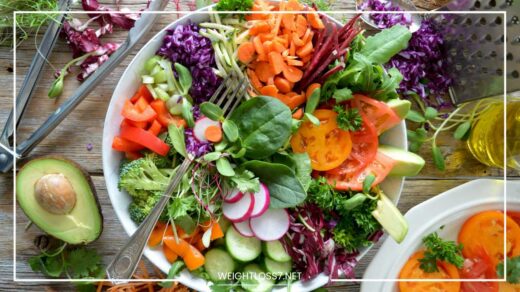How to Lose 20 Pounds in a Month

Lose 20 Pounds
Shedding Weight Safely: Aiming for Sustainable Results over Crash Diets
The allure of dropping 20 pounds in a month is undeniable, especially with a big event on the horizon. However, achieving this level of weight loss safely and sustainably is a challenging feat.
Crash diets and extreme exercise routines may lead to quick results, but they are often unsustainable and can be detrimental to your health.
This blog post prioritizes healthy habits that can help you lose weight and keep it off for good. We’ll explore practical strategies for creating a calorie deficit, incorporating smart food choices, and getting your body moving. Remember, consistency is key!
Can You Really Lose 20 Pounds in a Month?
Let’s address the elephant in the room head-on: losing 20 pounds in a month is generally not recommended by health professionals. A safe and sustainable rate of weight loss is generally considered to be 1-2 pounds per week.
Here’s why rapid weight loss might not be the best approach:
- Muscle Loss: Crash diets often lead to muscle loss along with fat loss. Muscle is metabolically active tissue, meaning it helps you burn more calories at rest. Losing muscle can actually slow down your metabolism, making it harder to maintain weight loss in the long run. Imagine your body as a furnace; muscle is the fuel that keeps the fire burning. Crash diets essentially throw away some of those logs, leaving you with a weaker fire (metabolism) that struggles to burn calories effectively.
- Nutrient Deficiencies: Restrictive diets can make it difficult to get all the essential vitamins and minerals your body needs. This can lead to fatigue, weakness, impaired immune function, and other health problems. Think of your body as a complex machine. To run smoothly, it needs a variety of components (nutrients) working together. Crash diets often neglect some of these essential parts, leading to malfunctions (health issues).
- Unsustainable Habits: Crash diets are often based on deprivation, which can be challenging to maintain in the long term. This can lead to yo-yo dieting, a cycle of weight loss and regain that is unhealthy and frustrating. Imagine trying to climb a mountain by sprinting for short bursts, then collapsing from exhaustion. Crash diets are like those sprints; they might get you a little higher initially, but they’re not sustainable for reaching the peak (your weight loss goals).
Instead of focusing on a quick fix, let’s explore ways to create a healthy calorie deficit that will help you lose weight and keep it off for the long haul.
Shedding Pounds Through Calorie Management
Losing weight boils down to creating a calorie deficit. This means burning more calories than you consume each day. Here’s a roadmap to get you started:
- Calculate Your Basal Metabolic Rate (BMR): This is the number of calories your body burns at rest to maintain basic functions like breathing, circulation, and cell growth. There are many online calculators available to help you determine your BMR. Think of your BMR as the baseline number of calories your body needs to function like an idling car.
- Factor in Activity Level: Based on your daily activity level, you can estimate your Total Daily Energy Expenditure (TDEE), which is the total number of calories you burn each day. This considers activities like exercise, walking around at work, and even fidgeting. You can find online calculators or use wearable fitness trackers to estimate your TDEE.
- Create a Calorie Deficit: To lose weight, you need to create a calorie deficit. A safe starting point is to aim for a deficit of 500 calories per day. This will help you lose around 1 pound per week. However, it’s important to note that this is a general guideline.
Important Note: Consulting a registered dietitian or healthcare professional can help you determine a safe and personalized calorie goal based on your individual factors like age, sex, weight, height, and activity level. They can also help you create a meal plan that fits your preferences and ensures you’re getting all the nutrients you need.
Smart Food Choices for Sustainable Weight Loss
Making smart food choices is crucial for creating a calorie deficit and achieving your weight loss goals. Here are some tips to fill your plate with goodness and keep you feeling satisfied:
- Focus on Whole Foods: These are unprocessed or minimally processed foods that are closer to their natural state. They are generally packed with nutrients like vitamins, minerals, and fiber, and tend to be lower in calories than processed foods. Fill your plate with a rainbow of fruits and vegetables, choose whole grains like brown rice or quinoa over refined grains like white bread, and opt for lean protein sources like chicken, fish, beans, and lentils. Think of whole foods as nutrient powerhouses that give your body the building blocks it needs to function optimally and feel full.
- Embrace Protein: Protein helps you feel satisfied and reduces cravings. It also plays a role in building and repairing muscle tissue, which as we discussed earlier, is crucial for maintaining a healthy metabolism. Include protein sources in every meal and snack. Explore lean meats, poultry, fish, tofu, tempeh, eggs, beans, lentils, and nuts (in moderation due to their calorie content).
- Don’t Fear Healthy Fats: Healthy fats, like those found in avocados, nuts, seeds, olive oil, and fatty fish, can help you feel full and satisfied. They also play a vital role in hormone regulation and nutrient absorption. Include healthy fats in moderation as part of a balanced diet.
- Limit Processed Foods: Processed foods are often loaded with calories, unhealthy fats, added sugars, and sodium. These can contribute to weight gain and other health problems. Processed foods are often designed to be hyper-palatable, meaning they trigger strong cravings that can make it difficult to stick to your calorie goals. Limit processed foods like sugary drinks, packaged snacks, fast food, and processed meats. When reading food labels, be mindful of added sugars and choose options lower in sodium.
- Become Label Savvy: Reading food labels empowers you to make informed choices. Pay attention to serving sizes and calorie counts. Look for foods with a high fiber content, as fiber can help you feel full and promote satiety. Be wary of misleading marketing claims and focus on the actual nutritional content.
Incorporating Exercise for a Well-Rounded Approach
Exercise plays a vital role in weight loss and overall health. Here’s how to get your body moving and create a sustainable routine:
- Find Activities You Enjoy: The key to sticking with an exercise routine is finding activities you genuinely enjoy. This could be anything from dancing to swimming, hiking to cycling, or team sports. When you find activities you find fun, you’re more likely to make them a regular part of your life.
- Start Gradually: Don’t try to go from couch potato to gym rat overnight. Begin with a manageable exercise routine and gradually increase the intensity and duration as your fitness level improves. This will help prevent injuries and burnout.
- Embrace Variety: Mix up your workouts to keep things interesting and challenge your body in different ways. This could involve incorporating cardio, strength training, and flexibility exercises into your weekly routine. Aim for at least 150 minutes of moderate-intensity cardio or 75 minutes of vigorous-intensity cardio each week as recommended by the CDC. Strength training exercises that target all major muscle groups 2-3 times per week are also crucial for building muscle and boosting your metabolism.
- Make it a Lifestyle Choice: View exercise as a way to invest in your health and well-being, not just a means to lose weight. The benefits of regular physical activity extend far beyond the scale, including improved mood, reduced stress, stronger bones and muscles, and a lower risk of chronic diseases.
Remember, even small increases in daily activity can make a difference. Take the stairs instead of the elevator, park further away from your destination, or go for a short walk during your lunch break. Every step counts!
Building Sustainable Habits for Long-Term Success
Crash diets and extreme exercise routines may provide short-term results, but they are not sustainable in the long run. Here’s how to build healthy habits that will help you reach your weight loss goals and keep the weight off:
- Set SMART Goals: Specific, Measurable, Achievable, Relevant, and Time-bound goals will help you stay motivated and on track. Instead of aiming to lose 20 pounds in a month, set a goal of losing 1-2 pounds per week. This is a more realistic and sustainable approach.
- Find Your Support System: Surround yourself with positive and supportive people who will encourage you on your weight loss journey. This could be a friend, family member, workout buddy, or even an online support group. Having a support system can help you stay accountable and motivated, especially when challenges arise.
- Make Gradual Changes: Trying to overhaul your entire lifestyle overnight is a recipe for disaster. Instead, focus on making small, sustainable changes that you can stick with over time. Gradually swap sugary drinks for water, replace processed snacks with fruits and nuts, and add a short walk to your daily routine. These small changes can add up to big results in the long run.
- Practice Mindful Eating: Pay attention to your hunger and fullness cues. Eat slowly and savor your food. Avoid distractions like watching TV or scrolling through your phone while eating. Mindful eating can help you develop a healthier relationship with food and prevent overeating.
- Don’t Deprive Yourself: Restrictive diets often lead to cravings and binge eating. Allow yourself occasional treats in moderation. This will help you stay on track and prevent feelings of deprivation.
- Celebrate Non-Scale Victories: Weight loss isn’t just about the numbers on the scale. Celebrate non-scale victories along the way, such as having more energy, fitting into your old clothes, or completing a workout you previously found challenging. Recognizing these achievements will help you stay motivated and focused on your long-term goals.
- Be Patient and Kind to Yourself: Weight loss takes time and effort. There will be setbacks along the way. Don’t beat yourself up if you have a slip-up. Just get back on track and keep moving forward. Remember, progress over perfection is key.
Remember: This journey is about creating a healthy lifestyle that you can maintain for life. By focusing on healthy habits, making gradual changes, and being kind to yourself, you can achieve your weight loss goals and improve your overall well-being.
Additional Tips for Success:
- Get Enough Sleep: When you’re sleep-deprived, your body produces more of the stress hormone cortisol, which can lead to increased appetite and cravings. Aim for 7-8 hours of quality sleep each night.
- Manage Stress: Chronic stress can also contribute to weight gain. Find healthy ways to manage stress, such as yoga, meditation, or spending time in nature.
- Stay Hydrated: Drinking plenty of water can help you feel full and reduce your calorie intake. Aim for eight glasses of water per day.
- Cook More Meals at Home: Cooking at home gives you more control over the ingredients in your food. This allows you to choose healthier options and portion sizes.
- Meal Prep: Planning and prepping your meals in advance can help you stay on track and avoid unhealthy temptations when you’re short on time.
- Find a Registered Dietitian: A registered dietitian can help you create a personalized meal plan that meets your individual needs and preferences. They can also provide guidance on healthy eating habits and portion control.
Final Word:
Losing weight and keeping it off is a marathon, not a sprint. By focusing on healthy habits, creating a calorie deficit, and incorporating exercise into your routine, you can achieve your weight loss goals and improve your overall health. Remember, consistency is key!
This blog post has equipped you with the knowledge and tools to embark on a sustainable weight loss journey. It’s time to ditch the crash diets and embrace a healthy lifestyle that empowers you to reach your goals and feel your best.

















